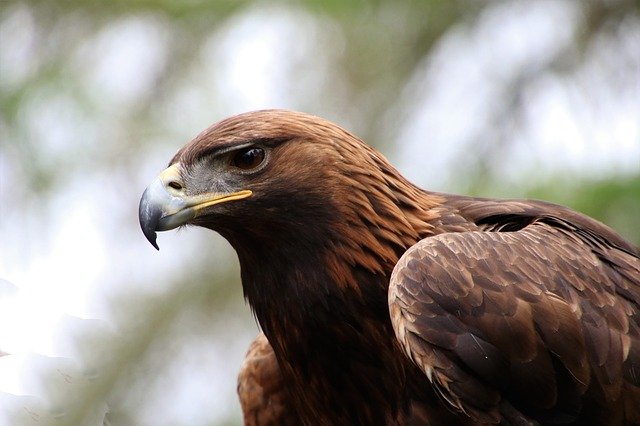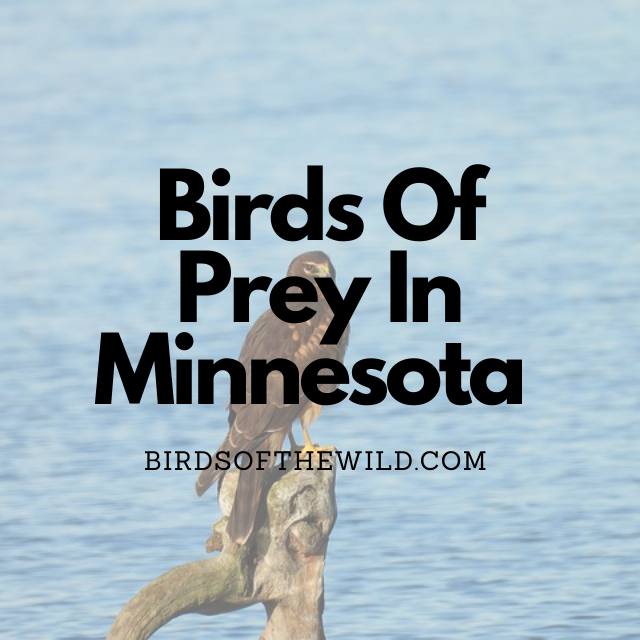Minnesota has a large variety of birds of prey known to hunt smaller animals and even other birds. In this article I’ll be going over 9 birds of prey that can be found throughout the state of Minnesota along with a few facts about these birds to satisfy your curiosity.
- Red Tailed Hawk
- Bald Eagle
- Golden Eagle
- Great Horned Owl
- Red Shouldered Hawk
- Sharp Shinned Hawk
- Cooper’s Hawk
- Northen Goshawk
- Northern Harrier
9 Birds Of Prey In Minnesota
1. Red Tailed Hawk (Buteo Jamaicensis)

- Size: 45 – 60cm
- Weight: 1.25 – 1.47kg
- Wingspan: 100 – 150cm
You’ll be able to spot red tailed hawks throughout central and southern Minnesota year round, whilst they can be found in the remainder of the state when they’re breeding.
Red tailed hawks are recognised by their brown torso and wings, white breast and red tails. The main difference between the male and females is that the females are a third larger than the males.
These red tailed avians spend their time at a variety of places within the state including deserts, grasslands, forests, agricultural fields and urban areas.
Red tailed hawks are carnivorous birds of prey where they feed on small mammals, rodents, other smaller birds, fish and even carrion.
In the wild red tailed hawks are known to live between 15 – 20 years whilst captive red tails can live on the upper end of that spectrum around 20 years.
2. Bald Eagle (Haliaeetus Leucocephalus)

- Size: 90 – 108cm
- Weight: 3 – 6.3kg
- Wingspan: 180 – 250cm
Blad eagles are winter residents around southern and central Minneosta whilst in the remainder of the state they’ll stay throughout spring and summer when breeding.
A bald eagle’s plumage consists of dark brown around its wing and body, with white feathers on its tail and head along with the trademark yellow beak and feet. Both male and female bald eagles look relatively the same.
As for where you can find these eagles, it will often be around lakes and reservoirs with lots of fish and surrounding forests. You’ll often find them around unfrozen lakes and hunting along coastlines, reservoirs, and rivers during the winter months
These eagles are birds of prey meaning they hunt other birds, medium sized mammals like rabbits, hares, other animals like reptiles, fish and even eat carrion when their options are limited. Sometimes bald eagles are recognised as fish eagles as their diet consists of fish and as meat is the only thing they eat these eagles would ultimately be regarded as carnivores too.
Blad eagles can live for around 20 years in the wild.
3. Golden Eagle (Aquila Chrysaetos)

- Size: 70 – 82cm
- Weight: 3.7 – 5.3kg
- Wingspan: 190 – 212cm
You’ll be able to spot golden eagles in Minnesota througout their non-breeding season of fall and winter.
Golden eagles are recognised by their mostly light brown and dark brown plumage, yellow feet and black downwards pointing beak. Females once again are the larger of the 2 birds where males are roughly 33% smaller in size.
These eagles spend the majority of their time within open moorlands and mountains within the likes of Scotland, and many areas within north America
Golden eagles do eat carrion but, it isn’t their first choice of food when hunting for prey. If they do find a dead carcass they will eat it, with their general food choices consisting of smaller mammals, birds and sometimes larger prey.
These eagles are known to live for around 14 years in the wild whilst captive are even able stay alive till their early 30’s with the longest observed at 32 years old.
4. Great Horned Owl (Bubo Vrginianus)

- Size: 57 – 63cm
- Weight:1 .4 – 15kg
- Wingspan: 1.35 – 1.5m
Great horned owls can be found all throughout MInnesota year as it’s a permenant residence of theirs.
These large horned owls are recognised by their brown/gray plumage with their defining feature being the tuft of feather on the top of their head resembling a horn or ear like feature. Male and female great horned owls look relatively the same with the females slightly larger in size.
At night these birds will perch on a branch or a tall building to look around for prey and once the desired prey has been found they will fly towards it with folded wings, grab the prey with their talons piercing through their body and in most cases killing them immediatley.
As for what these birds eat it includes smaller prey like rodents, frogs or scorpions. Even other larger predators like geese, ducks, hawks, and smaller owls can be eaten by these carnivorous birds.
Great horned owls are most commonly found in deserts, wetlands, forests, grasslands, backyards, cities and they can also be found in semi-open habitats between the Arctic and the tropics.
As for a great horned owls lifespan, it can be anywhere from 15 -25 years.
5. Red Shouldered Hawk (Buteo Lineatus)

- Size: 38 – 48cm
- Weight: 540 – 720 grams
- Wingspan: 94 – 107cm
These red shouldered hawks are spring and summer residents around central Minnesota when they happen to breed.
Red shouldered hawks are recognised by their orange colored breasts, face and neck, red coloured shoulders, their patterned dark brown white wings and tail feathers. Both males and females look the same but, the females are the larger of the 2 by around 25 – 30%
These hawks can be spotted around mixed deciduous coniferous forests with open understories. They particularly prefer wet forests, especially bottomlands near streams, rivers, swamps, and marshes.
Red shouldered hawks are birds of prey and in turn will often consume amphibians, reptiles, birds, mammals and crayfish.
The average red shouldered hawk would live around 15 – 19 years whilst captive ones have been known to live for around 26 years.
6. Sharp Shinned Hawk (Accipiter Striatus)

- Size: 23 – 37cm
- Weight: 82 – 220 grams
- Wingspan: 42 – 68cm
Sharp shinned hawks can be found in southern Minnesota year round whilst in the remainder of the state they will be spring and summer breeding residents.
These hawks are recognised by their gray wings and back, brown and white breast and belly with a pair of yellow feet. Females look very similar to the males but are roughly a third larger.
Sharp shinned hawks can be found around mixed or coniferous forests, open deciduous woodlands, thickets, edges
These hawks will often eat birds from the size of a sparrow up to that of a robin’s size and in rare occasions some birds that are the size of quails too. They also eat the occasional rodent, bats, squirrels, lizards, frogs, snakes, and large insects.
Sharp shinned hawks will typically live for around 5 – 6 years on average, although some are able to live 10+ years in the right environment.
7. Cooper’s Hawk (Accipiter Cooperii)

- Size: 35 – 51cm
- Weight: 400 – 700 grams
- Wingspan: 73 – 94cm
You’ll be able to find these hawks around the southern border of Minnesota year round whilst they’ll be in the rest of the state when breeding.
Cooper’s hawks are recognised by their gray back and upper head with a orange and white patterned breast, legs and underside of the wing. The females and males look very much the same but, the females are around 30% larger than the opposite gender.
You’ll often find a cooper’s hawk around pines, oaks, Douglas-firs, beeches, spruces, and other tree species, often on flat ground rather than hillsides, and in dense woods.
As for what they eat, it includes mainly medium-sized birds including robins, jays, flickers, among other smaller and even larger birds. Small mammals like chipmunks, tree squirrels, ground squirrels, mice, bats, etc. are included in their diet too.
Cooper’s hawks tend to live for around 10 – 12 years on average whilst the oldest recorded hawk surpassed the 20 year mark.
8. Northern Goshawk (Accipiter Gentilis)

- Size: 55 – 61cm
- Weight: 0.63 – 1.4kg
- Wingspan: 105 – 115cm
Northern goshawks are year round residents around northeast Minnesota whilst they will be non-breeding residents in the remainder of the state.
These hawks are recognised by their moslty gray and white plumage with a horizontal zebra like gray pattern across their belly and breasts. The females are generally a more brown color and are also bigger in size.
You’ll often spot northern goshawks around deciduous and coniferous forests.
They’ll generally feed on smalller rodents, mammals and birds like snowshoe hare, rabbit, gray and red squirrels, chipmunks, weasels, ducks, grouse, quail, pheasants, crows, small hawks, owls, woodpeckers, blackbirds, blue jays, grasshoppers, as well as insects like moth and beetle larvae.
Northern goshawks are known to live for around 7 years on average, with the longest living ones achieving a lifespan of 19 years.
9. Northern Harrier (Circus Cyaneus)

- Size: 41 – 50cm
- Weight: 340 – 500 grams
- Wingspan: 105 – 115cm
Northern harrier’s can be found around the southern border of the state year round. In the rest of the state you’ll spot northern harriers sticking around across their season of breeding.
Female northern harrier’s are a mixture of light and dark brown where their wings are a darker brown color with their breast a light brown color with darker brown spots throughout. Males on the other hand are gray and white in color whilst. Females are also significantly bigger than the males.
You’ll often spot northern harriers around lowland farmland, heathland, coastal marshes, fenland, river valleys, moorlands among other open areas with low vegetation.
Northern harriers are known to eat small mammals and small birds, although on occasion they may eat bigger prey like rabbits and ducks too.
These birds are known to have live for a max of 16 years and 5 months but, on average they rarely eclipse the 8 year mark.
Amhil Khan, a dedicated nature enthusiast and the founder of BirdsOfTheWild.com, is a passionate advocate for the captivating world of avian wonders. With a deep-seated curiosity about the intricate lives of birds, Amhil’s journey began as a fascination and has evolved into a mission to inspire others to appreciate and protect these magnificent creatures.
Amhil’s love for birds led to the creation of Birds of the Wild, a platform where his expertise in ornithology, coupled with his captivating storytelling, provides readers with an immersive and educational experience. Through his lens and words, he captures the essence of birds in their natural habitats, offering a glimpse into their behaviors, migrations, and the ecosystems they inhabit.

